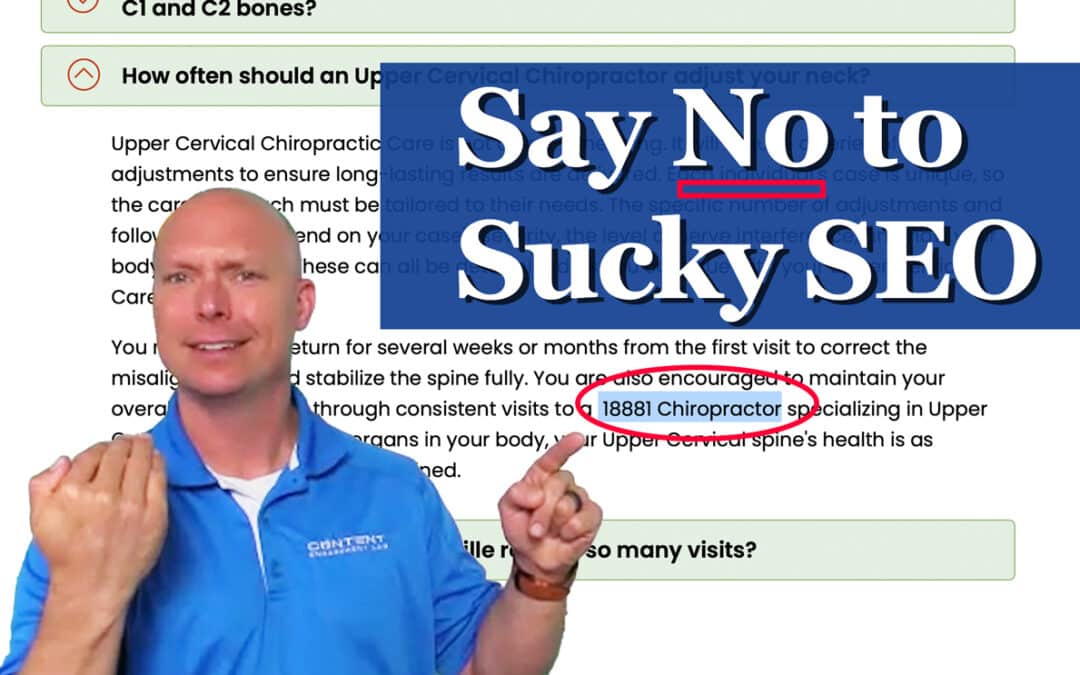In the world of digital marketing, few things are as frustrating as encountering outdated, poorly written copy on a client prospect’s website.
Just the other day, I stumbled upon a site that took me straight back to the dark ages of SEO. Picture this: an FAQ area crammed with zip codes awkwardly plopped in front of targeted keywords. Yes, you read that right – ZIP CODES. As if that wasn’t enough, the same site liberally sprinkled the infamous “[Keyword] + near me” phrase throughout its content. It’s the kind of thing that makes any self-respecting marketer cringe.
Let’s break this down. First, the whole “[Keyword] + near me” trend has been done to death. Not only does it sound horrible, but it also reeks of desperation. Slapping “near me” onto everything from H1 headers to image descriptions and captions? It’s the SEO equivalent of trying to win a gourmet cooking contest with instant ramen. Even a slight improvement, like switching to “[Keyword] + near you,” sounds marginally better, but it’s still painfully salesy.
This lazy approach to SEO might have worked in the early 2000s, but it’s 2024, people. The digital landscape has evolved, and so have the algorithms that drive it. Google Gemini AI and other advanced systems are increasingly focused on providing users with the best possible content. This means understanding and addressing user intent, providing real value, and creating genuinely engaging content.
Business Owners and Top Brass, Listen Up
Your content is your digital handshake. It’s the first impression potential customers get of your business. Do you really want that first impression to scream, “We’re stuck in 2010”? Especially now, with AI technologies like Google Gemini delivering single, best recommendations instantly, you can’t afford to cut corners.
Poorly written, keyword-stuffed content not only fails to engage but also risks penalizing your site in search rankings. If you want your business to have any digital prominence—and let’s face it, that means customers—you need to get this right.
Here’s how:
- Invest in Quality Content: Hire professional writers who understand both SEO and human psychology. Your content should be optimized for search engines but, more importantly, it should resonate with your audience.
- Understand Your Audience: Use data-driven insights to identify your target customers’ pain points and needs. Create content that addresses these issues in a meaningful way.
- Stay Updated with SEO Best Practices: SEO is not a set-it-and-forget-it task. Algorithms change, and so should your strategies. Keep up with the latest trends and updates in the SEO world.
- Focus on Value: Every piece of content should provide real value to your audience. Whether it’s an informative blog post, an engaging video, or a helpful infographic, make sure it’s something your audience will find useful.
- Optimize Continuously: Monitor the performance of your content regularly. Use analytics to see what’s working and what’s not, and be prepared to tweak your strategy accordingly.
Saying no to sucky SEO isn’t just about avoiding outdated tactics—it’s about committing to a higher standard of content. It’s about ensuring that every piece of content you put out is a true reflection of your brand’s quality and value. So, next time you’re tempted to take a shortcut with your SEO strategy, remember: your content is your digital handshake. Make it count.


Recent Comments